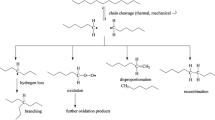Abstract
Results of a study on polyethylene, polyvinyl chloride, latex and polypropylene films by photocolorimetry are described. The polymeric films were subjected to destructive environmental factors as ozone, ultra-violet irradiation and γ-radiation. It is shown that these factors can lead to a reduction or an increase of transparency. This fact is due to the mechanisms of crosslinking, crystallization and destruction of macromolecules. Correlation between the photocolorimetry data and distributions of relaxation times of a nuclear magnetic resonance of protons in different sites of the polymeric network received earlier is established.







Similar content being viewed by others
Abbreviations
- LLDPE:
-
Linear low-density polyethylene
- HDPE:
-
High-density polyethylene
- PVC:
-
Polyvinyl chloride
- PP:
-
Polypropylene
- UV:
-
Ultraviolet
- NMR:
-
Nuclear magnetic resonance
References
Zaikov GE, Jimenez A (2005) New developments in polymer analysis, stabilization and degradation, Nova Sci. Publ., New York
Brandrup J, Immergut EH, Grulke EA (eds) (2003) Polymer handbook, 2 volumes set. 4th edn. John Wiley & Sons, Inc, New York
Rabek JF (2012) Polymer photodegradation: mechanisms and experimental methods. Springer-Science+Business Media, Dordrecht
Cheneler D, Bowenb J (2013) Degradation of polymer films. Soft Matter 9: 344–358
Yousif E, Haddad R (2013) Photodegradation and photostabilization of polymers, especially polystyrene: review. SpringerPlus 2:398
Wypych G (2008) PVC degradation & stabilization. ChemTec Publishing, Toronto
Cho S, Choi W (2001) Solid-phase photocatalytic degradation of PVC–TiO2 polymer composites. J Photochem Photobiol A 143:221–228
Hidaka H, Suzuki Y, Nohara K, Horikoshi S, Hisamatsu Y, Pelizzetti E, Serpone N (1996) Photocatalyzed degradation of polymers in aqueous semiconductor suspensions. I. Photooxidation of solid particles of polyvinylchloride. J Polym Sci A 34: 1311–1316
Horikoshi S, Serpone N, Hisamatsu Y, Hidaka H (1998) Photocatalyzed degradation of polymers in aqueous semiconductor suspensions. 3. Photooxidation of a solid polymer: TiO2-Blended Poly(vinyl chloride) Film. Environ Sci Technol 32:4010–4016
Ohtani B, Adzuma S, Nishimoto S, Kagiya T (1992) Photocatalytic degradation of polyethylene film by incorporated extra-fine particles of titanium dioxide. Polym Degrad Stab 35:53–56
White JL, Choi D (2005) Polyolefins processing, Structure Development, and Properties. Hanser Verlag, Munich
Yousif E, Haddad R (2013) Photodegradation and photostabilization of polymers, especially polystyrene: review (Springer Plus 2) http://www.springerplus.com/content/2/1/398
Shultz AR (1979) Polymer film photodegradation: optical density effects durability of macromolecular materials. American Chemical Society, Washington DC, 95: 29–43
Chernov VM, Butakov AV (2010) Bulletin of South Ural State University, series “Mathematics. Mechanics. Physics” 3:105–111
Chernov VM (2009) Nuclear magnetic relaxation and molecular motion in elastomers and lyotropic liquid crystals. Dr. Sci. Thesis. Chelyabinsk State University, Chelyabinsk, p 316
Bogaychuk A, Sinyavsky N, Kupriyanova G (2016) Investigation of polymer degradation using NMR relaxometry with inverse laplace transformation. Appl Magn Reson. DOI:10.1007/s00723-016-0833-1
Marino I-G Regularized Inverse Laplace Transform. http://www.mathworks.com/matlabcentral/fileexchange/6523-rilt/content/rilt.m (2004)
Acknowledgements
This work was supported by Federal Agency for Fisheries of the Russian Federation.
Author information
Authors and Affiliations
Corresponding author
Rights and permissions
About this article
Cite this article
Sinyavsky, N., Korneva, I. Study of Optical Properties of Polymeric Materials Subjected to Degradation. J Polym Environ 25, 1280–1287 (2017). https://doi.org/10.1007/s10924-016-0908-y
Published:
Issue Date:
DOI: https://doi.org/10.1007/s10924-016-0908-y




